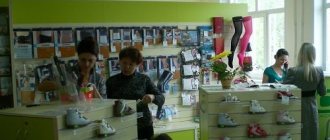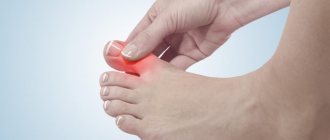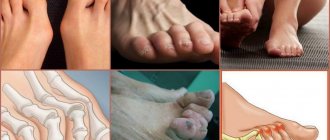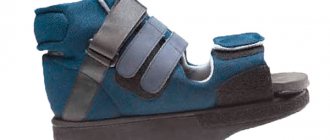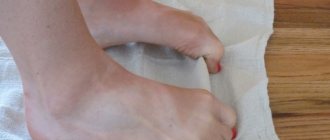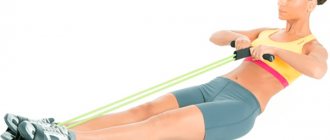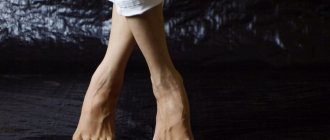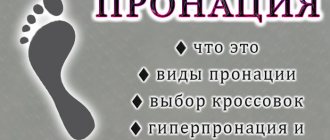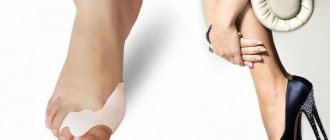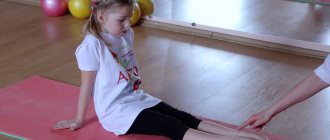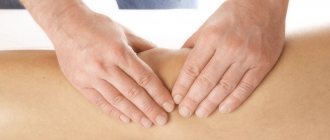Why wear orthopedic shoes after surgery?
Despite the fact that surgery allows you to get rid of deformation of the thumb joint, the postoperative area requires increased attention from the patient. As negative consequences, the patient may experience inflammation, pain and repeated deformities.
Wearing orthopedic shoes will help to fully restore the foot after surgery and prevent re-deformation of the articular and connective tissues.
The main functions of postoperative orthopedic shoes are to achieve the following goals:
- Fixation of the operated joint - a properly made toe part of the shoe does not squeeze the toes, eliminates the load on the operated joint and at the same time gently fixes it, which allows for faster tissue restoration and avoids repeated pathological transformation;
- Load absorption – properly selected shoes soften high loads on the foot when walking and running, distribute loads evenly, thereby reducing the risk of injuries and pathological changes in the musculoskeletal system;
- Restoring blood supply - massage insoles and correctors help stimulate blood supply in the area of surgical intervention, which is aimed at accelerating tissue regeneration, healing and restoration;
- Elimination of curvature of the toes - hallux valgus is always accompanied by a curvature of the big toe, which exerts deforming pressure on the other toes of the diseased foot. Special orthopedic shoe correctors help correct this.
- Comfort for the patient - rehabilitation orthopedic shoes may be visually no different from ordinary ones, but at the same time they provide the patient with long-term comfortable wearing, eliminate swelling and reduce leg fatigue.
Why hallux valgus occurs in children - causes and predisposing factors
Parents often ask the question whether children with identified hallux valgus deformity require orthopedic shoes, which must be specially selected.
To prevent the child from suffering from pain in the legs in the future, parents should address this problem as early as possible.
A foot with a valgus position may appear due to:
- Congenital diseases, developmental anomalies.
- Inherited diseases.
- Dysplasia, various genetic disorders.
- Acquired problems from rickets.
- Getting on your feet early.
- Leg injuries.
- Inappropriate first shoes.
When this is a congenital problem , then the child needs to begin treatment even before the first step.
Having an acquired nature , the deformation can occur due to incorrect selection of shoes, when parents independently choose sandals with soft backs and a flat insole. When walking, weak ligaments in the legs are not able to support the weight of the child, so the ankles collapse under his own weight. Using a walker too early also leads to negative consequences.
Design features of rehabilitation shoes
Despite the large number of different models of postoperative shoes, they all have common design and tailoring features. When choosing the optimal shoe model, the specialist pays attention to the following elements and characteristics:
- Back - the presence of a hard back helps to securely fix the joints and prevents re-deformation. The height is calculated individually according to the size of the foot. Most often, experts recommend choosing shoes with a heel that is at least 3 cm higher than the heel.
- Anatomical instep support - the task of this shoe element is to fix the arch of the foot and evenly distribute the load. This allows you to avoid injuries and pathological changes in joint structures.
- Laces or Velcro – after surgery, it is advisable to wear shoes that secure the foot tightly. To do this, you should give preference to models that have lacing or Velcro, allowing you to adjust the tightness of the shoe to your foot.
- Metatarsal pads are special silicone pads located in the toe part of the shoe that reduce friction between the toes, protect the toes from deformation and calluses, and prevent the foot from slipping in the shoe.
- Hammer-shaped correctors are special devices that fit onto the fingers and separate them. This reduces the pressure of the crooked toe on the rest of the toes.
- Soft toe - the toe of a rehabilitation shoe should not be narrow, should not squeeze or bind the toes, and the sole in the toe should be relatively soft and flexible.
- Sole and heel - the sole of orthopedic shoes must have a special shape and design, which allows you to properly distribute and reduce the load when walking and running. Heel: people who have undergone surgery to remove a bunion can wear shoes and sandals that have a stable, wide heel, no more than 4 cm in height.
- Material – safety shoes must provide good air permeability. This eliminates the accumulation of moisture in closed shoes and prevents fungal infections of the foot, which are unacceptable in the postoperative period. To do this, rehabilitation shoes must be made from high-quality, preferably natural materials - leather, suede, soft textiles, etc.
The best option for choosing postoperative orthopedic shoes is to have a suitable model made to order. This will allow taking into account the individual characteristics of the anatomy of the foot and its condition after the intervention.
Characteristic signs of flat feet
To check how correctly a child’s foot is forming, you can use this home diagnostic method: lubricate the baby’s feet with paint or rich cream and ask him to take a step on a clean sheet of paper. This way you will get a clear imprint of the child's foot and will be able to analyze it for any deformities.
If the characteristic notch at the inner edge of the foot on the print occupies less than half the width or is displayed entirely on the sheet, then you need to contact a specialist as soon as possible to confirm the diagnosis and receive recommendations for correcting the defect.
Attention! Until the age of 3, this diagnostic method does not make sense to use, since children still have an impressive fat pad in the sole area.
In adolescents and adults, flat feet can be suspected if the legs get tired quickly, after physical activity there is pain in the feet, the ankles constantly or periodically swell, there is a feeling that the width and length of the feet have increased.
Indications for the use of rehabilitation shoes
Orthopedic shoes are indicated for the prevention and treatment of any foot deformities, including hallux valgus. For children and teenagers, the right shoes can completely solve the problem.
Experts prescribe orthopedic shoes for patients with the following pathologies:
- Hallux valgus - the formation of a bone on the lateral surface of the foot is accompanied by a number of its pathologies and improper load distribution. Wearing orthopedic shoes reduces the load on the forefoot, thereby helping to eliminate inflammation and pain in this area and reduce the protruding bump.
- Flatfoot is a flattening of the arch of the foot, which often accompanies hallux valgus. With flat feet, the arch of the foot is not able to absorb shock and weight loads that occur when walking and running. Orthopedic shoes with special insoles and arch supports will help reduce the load on the foot and protect the patient’s musculoskeletal system from injuries and serious illnesses.
- Weakness of the ligamentous apparatus - this pathology underlies all foot deformities. Wearing orthopedic shoes involves fixing the foot in the correct position, which in turn puts stress on the muscles and ligaments. Regular use of weak structures of the musculoskeletal system during walking and running helps to gradually strengthen them.
- Excess weight – even slight excess weight becomes a difficult ordeal for sore feet. Orthopedic shoes evenly distribute the load onto its most durable and resistant parts.
- Joint deformities – pathological changes in the joints develop against the background of diseases such as arthritis and arthrosis, as well as with high loads on the legs and prolonged wearing of high heels. Constantly wearing orthopedic shoes allows you to fix the joints in the correct position and return them to a healthy state.
- Spinal diseases - scoliosis, osteochondrosis and other diseases of the musculoskeletal system can cause severe curvature of the foot structures. Orthopedic shoes reliably protect the lower limbs from deformation.
- Diabetic foot - if hallux valgus develops in a patient suffering from diabetes, it is advisable to wear orthopedic shoes throughout his life to prevent the development of hyperkeratosis and loss of tissue sensitivity.
Signs and symptoms of hallux valgus in children - how to notice in time?
At an appointment, when an orthopedist diagnoses this problem, the diagnosis is often made that the child’s feet are flat and have a valgus position.
Parents are able to identify the distinctive features of valgus in children themselves.
In children with flat-valgus feet:
- The midfoot sags; both toes and heels deviate outward.
- When a child stands, it is noticeable that his legs look like the letter “X”.
- The shoes begin to wear down quickly, deformation of the inner part of the foot occurs, and the sole wears off.
- Children are often tired and their feet and knees hurt.
- Swelling may sometimes appear in the ankles and feet.
In such a situation, parents need to consult an orthopedist - which, in this case, can have a positive effect if you follow all medical recommendations.
Video: Foot valgus in children - what it is and how to avoid it
Types of surgeries to correct curvature of the legs
The doctor will prescribe massage and physiotherapeutic procedures .
To get a full result, correct this deformity, change the position of the foot, you need to use orthopedic shoes - but only correctly selected ones.
Types and features of models of postoperative orthopedic shoes
All orthopedic shoes are traditionally divided into preventive and therapeutic, as well as for adults and children. Models recommended for patients who have undergone bunion removal surgery fall into the category of complex orthopedic shoes.
Separately, we should consider models recommended for patients with hallux valgus, complicated by inflammatory processes and diabetic lesions. Such models are further modified (insoles are selected, open seams are removed, etc.) taking into account the patient’s concomitant pathology.
Depending on the season and place of wear, all models of postoperative orthopedic shoes can be divided into several types:
- Homemade products . Even after a low-traumatic laser surgery to remove hallux valgus, the patient will have to spend some time in the hospital and then at home. During this period, doctors do not recommend that the patient walk barefoot. Home orthopedic shoes should be made of hypoallergenic textiles or soft leather. It is advisable to choose models with a closed nose or in the form of special flip-flops.
- Summer models . The Russian market offers a wide range of summer orthopedic shoes. Visually, these shoes are in no way inferior to conventional models. Orthopedic models of sandals, sandals, moccasins, clogs and other modern shoes have design features and provide for fixation of the foot. When sewing summer rehabilitation shoes, they are often impregnated with special antibacterial and antifungal compounds. This is a huge advantage during the recovery period after surgery, when the risk of infection is especially high.
- Shoes for winter and off-season . Closed orthopedic shoes (shoes, boots, ankle boots) have an additional therapeutic effect and must have an anti-slip, stable sole. Most often, TEP material is used for this purpose, which does not slip on ice. Preference should be given to models made from natural materials that can retain heat without overheating the operated leg.
The Russian market offers orthopedic shoes of various models and manufacturers. Among imported products, the most popular are shoes from the German companies Berkemann and Ortmann. Among Russian brands, the most popular models are Ortomoda.
Correctors for hallux valgus
In addition to shoes and insoles, there are special orthopedic corrector pads for fixing the big toe in the anatomically correct position. This corrector is attached to the inner surface of the metatarsophalangeal joint of the first toe and is fixed in the space between the first and second toes. This ensures that the first toe returns to its anatomical position. When wearing the corrector for a long time, the joint restores its physiological shape, pain and discomfort are gradually relieved.
It is important to wear a corrector during surgical treatment of hallux valgus - before surgery it serves to prepare the foot, and in the postoperative period it is necessary to ensure smooth rehabilitation by unloading the foot and preventing recurrence of the deformity. Correctors differ depending on their design features and the material from which they are made.
Rules for caring for orthopedic shoes
Postoperative orthopedic shoes require careful handling and constant care. This will help protect shoes from adverse environmental influences and increase the service life of the products. Let’s formulate the basic rules for caring for rehabilitation shoes:
- In order for shoes to last a long time, they must be selected strictly according to the size of the foot;
- when putting on shoes, use a shoe horn to avoid the heel kinking;
- when removing shoes, do not step on the heel, as this can lead to irreversible damage to the shoes;
- shoes made of genuine leather must be treated with shoe polish before wearing;
- when choosing care products, preference should be given to professional products that match the material and its color;
- it is strictly forbidden to wash leather shoes with soap and rub them with oil;
- proper drying of shoes should be carried out at room temperature, without the use of heating devices;
- You cannot wear closed orthopedic shoes on bare feet.
Women's shoes for flat feet
Flat feet can cause a woman a lot of inconvenience, because following fashion trends and the extremely unhealthy principle “beauty requires sacrifice,” they buy a pair of high heels, which only aggravates problems with the limbs.
When diagnosing a disease, experts recommend at least temporarily abandoning extremely high stiletto heels, but not going to extremes by choosing a product with a flat, inflexible sole. The optimal solution would be to buy medium-height shoes or sandals with heels up to 5 cm. When choosing a model, it is better to choose a pair made of soft leather, suede, nubuck, on the inside of which there are no seams that put additional pressure on problem areas that provoke the development of soft and hard calluses .
You should not ignore the disease at stages 1-2, because it is during this period that you can get by with “little blood” and return your feet to their normal shape. At the last stages, the deformations are already stable and it is almost impossible to correct them.
How to choose the correct size of orthopedic shoes?
To choose the right size for orthopedic shoes, it is not enough to simply measure your foot with a ruler. To ensure accurate measurements, you should use a simple but reliable method - place a piece of paper on a flat floor and place your foot vertically on it, transferring your body weight to the leg being measured. Next, carefully outline the foot with a pencil, holding it at a right angle to the sheet. The distance from the most protruding point of the heel to the tip of the big toe will be considered the one by which the shoe size is determined.
It is very important not to buy shoes that fit, as the foot lengthens somewhat when walking. Lack of free space leads to pinched fingers and increased stress on the joints. Larger shoes are even more dangerous. It is also very important to take into account the width of the foot in order to avoid compression of the tissues, which can lead to repeated deformation.
Prevention
Of course, you can avoid the onset of development of flat valgus foot by taking preventive measures from the very birth of the baby. There is no need to put a lot of stress on a small body, trying to stand out and start walking at an early age - this will cause temporary joy, which is fraught with complications. More often you can be allowed to walk barefoot, especially on special mats and massage tapes, while doing physical exercises and gymnastics.
Active sports are also great for children, and from the beginning of life, massage is considered a prerequisite.
Size chart for women's models
| Characteristics | Female models | |||||||||
| Metric system (see) | 22,5 | 23,5 | 24 | 24,5 | 25 | 25,5 | 26 | 26,5 | 27 | 28 |
| Shoe size | 35 | 36 | 37 | 37,5 | 38 | 39 | 40 | 40,5 | 41 | 42 |
By design
According to their design, insoles are divided into hard - frame and soft - frameless. To figure out which of them are suitable for a particular person, you should know the main characteristics, advantages and disadvantages.
To create rigid orthopedic insoles, special frames made of plastic, graphite or steel are used. Used to support the arch of the foot during prolonged standing or developing flat feet. Suitable for athletes and people who lead an active lifestyle. Pros: absorb moisture well, protect against calluses and corns. Cons: not very convenient to use.
- Comfort insoles TALUS 38K
1,000.00₽
Choose …
- Antibacterial orthopedic insoles Talus 92
1,300.00₽
Choose …
- Orthopedic insoles with unloading elements “Concept-Antishock” TALUS 69
1,700.00₽
Choose …
The advantages of soft orthopedic insoles include unloading the foot, uniform distribution of the load, eliminating discomfort, protecting tendons and ligaments. The main disadvantage is the lack of enhanced shock absorption, which is provided by hard liners. Used only in cases where there are no violations. Suitable for pregnant women and diabetics.
Frame:
Frameless:
Size chart for men's models
| Characteristics | Male models | |||||||||
| Metric system (see) | 25,5 | 26 | 27 | 27,5 | 28 | 29 | 30 | 30,5 | 31 | 32 |
| Shoe size | 39 | 40 | 41 | 42 | 43 | 44 | 45 | 46 | 47 | 48 |
Important selection criteria.
The most pressing problem is how to choose the right orthopedic insoles. The main goal of these products is to reduce the risk of diseases and eliminate signs of pathologies. The choice depends on your goals:
- Prevention. The inserts are suitable for pregnant women whose spine suffers from increased stress. They are also recommended for athletes and people who often have to carry heavy loads due to their type of activity. The models will be a real find for heel lovers.
- Convenience. Insoles are optimal for those with crooked toes, wide feet, high arches, and advanced stages of flat feet. Inserts protect deformed areas and prevent the development of complications.
- Therapy. They are used for many diseases that negatively affect the condition of the feet: heel spurs, rheumatoid arthritis, diabetes. You should first consult with an orthopedist.
You need to choose insoles according to your foot size. Products should fit snugly in shoes so that they do not move during walking. First, suitable inserts are selected, and then boots or shoes are selected.
Prices for services
In medical terms, the price of laser surgery to remove a bunion on one foot is 70 thousand rubles. Surgery on two legs will cost the patient 120 thousand. rubles This amount includes the following services:
- specialist consultation;
- effective and safe local anesthesia;
- laser resurfacing of protruding bone;
- suturing the incision site;
- hospital stay for several days;
- repeated consultation with a specialist and removal of sutures;
- selection of the optimal model of orthopedic shoes;
- a detailed explanation of all the rules of the rehabilitation period.
If the operation was not performed in our clinic, you can schedule a consultation with a qualified orthopedic surgeon to receive professional information regarding the correct choice of rehabilitation shoes. The cost of this service in our clinic is only 1,950 rubles.
Children's shoes for flat feet
Has your child been diagnosed with flat feet? In childhood, returning the feet to their normal shape is easier than fighting the disease in adulthood. To choose the right orthopedic shoes, you should first enlist the help of an experienced specialist. For successful correction, you need to bring your baby for preventive examinations to an orthopedist at least once every 3 months.
It is optimal to order corrective shoes in a special salon, where craftsmen will take individual measurements and make the right pair to order. Orthopedic shoes, boots, sandals for children must meet the following criteria:
- heel no more than 2 cm;
- flexible sole;
- laces or Velcro;
- tight back;
- high-quality instep support;
- anatomical insoles;
- breathable upper material.
To get the best results, it is recommended to combine wearing special shoes with doing exercises to strengthen muscles and attending therapeutic massage sessions.
Doctor's answers to common questions
Why are orthopedic shoes for rehabilitation so expensive?
A number of requirements are imposed on postoperative orthopedic shoes: the use of expensive natural materials, hypoallergenic impregnations and developed complex design solutions. The final cost of the model depends not only on the design and quality of the shoes, but also on the manufacturer.
Some domestic models are not inferior in quality to imported ones, while differing in a more favorable price. In addition, you should know that disabled children, disabled people of group 1, as well as low-income and large families can receive shoes for free as part of the state support program.
Can I wear high heels after surgery?
A low-traumatic laser bone removal technique allows you to completely restore the functional activity of the foot and quickly return to an active lifestyle. However, even such a gentle method of eliminating the consequences of hallux valgus does not pass without leaving a trace, and the patient must carefully monitor the condition of the “sick” foot.
Wearing high-heeled shoes is possible after the end of the rehabilitation period, but this is only permissible in rare cases and for a short time. For daily wear, you should choose comfortable orthopedic shoes with a heel height of no more than 4 cm.
Why do orthopedic shoes always put pressure and constrain your feet?
Many patients turn to their podiatrist asking if it is normal for orthopedic shoes to feel a little tight. The Internet and some medical publications indicate that such sensations in the patient can be considered normal, because special shoes must firmly fix and hold the foot.
In fact, any pressure and discomfort while wearing orthopedic shoes indicates that they are not fitted correctly. The fixation of the foot should not be felt physically and should not lead to tissue compression. Incorrect non-professional selection of orthopedic shoes can lead to aggravation of the pathological condition.
How to distinguish orthopedic shoes from fakes?
Today there is a huge number of shoe products on the market that position themselves as orthopedic shoes. In fact, marketers often use this move to attract the attention and trust of customers, but the shoes themselves have nothing to do with medical indications. In order not to make a mistake in your choice and not to overpay for a fake, you should definitely check the relevant certificates before purchasing.
How to distinguish a branded model from a fake
Uneven seams, protruding threads and cheap material easily give away a fake, but such defects are not always detected the first time. If you prefer exclusively branded items, pay attention to other details:
- high-quality shoes cannot be cheap;
- branded products are not sold at clothing markets, online auctions and in dubious retail outlets - only in branded stores;
- study the brand’s “chips” in advance and look for them in the model being analyzed: this could be a special placement of the logo inside or on the sole, seam stitch size, printed pattern, cut elements;
- a sharp unpleasant chemical smell indicates a fake;
- if the shoes run small, they are probably not original;
- try scanning the barcode on the box to get information about the product (in the case of a fake, the barcode will not be scanned).
Branded shoes are presented in a wide range of sizes, in contrast to fakes with the most popular sizes
Service life and care tips.
The duration of use of the devices is individual and depends on the person’s weight, gait characteristics, frequency of wearing, and physical activity. To maintain the functionality of the insoles, it is necessary to provide them with proper care:
- Do not wash the earbuds with running water or machine wash them.
- To remove dirt, simply wipe the surface with a soft cloth soaked in soapy water. Leather models are cleaned with alcohol. Detergents are not used because they contain a large number of harmful components.
- Drying is done daily and after wet cleansing, always in a natural way; products should not be hung on a radiator or placed in direct sunlight.
- If the insoles get wet along with your shoes, do not throw them away. The orthoses are made from waterproof materials, so this will not affect their functionality in any way. After drying, they will be ready for use again.
Hard insoles require careful care following the recommendations given. Damage caused by washing and drying will soon render the devices unusable.
Athletes can wear insoles for up to 2 years, ordinary people - up to 5 years. Gel and plastic products need to be replaced the fastest; they are designed for 6 months of use. Leather ones will last at least a year.
